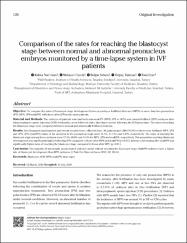| dc.contributor.author | Uzun, Kübra Nur | |
| dc.contributor.author | Cıncık, Mehmet | |
| dc.contributor.author | Selam, Belgin | |
| dc.contributor.author | Takmaz, Özgüç | |
| dc.contributor.author | Uyar, Esra | |
| dc.date.accessioned | 2021-06-17T06:24:38Z | |
| dc.date.available | 2021-06-17T06:24:38Z | |
| dc.date.issued | 2021 | en_US |
| dc.identifier.citation | Uzun, K. N., Cıncık, M., Selam, B., Takmaz, Ö. ve Uyar, E. (2021). Comparison of the rates for reaching the blastocyst stage between normal and abnormal pronucleus embryos monitored by a time-lapse system in IVF patients. Journal of the Turkish-German Gynecological Association, 22(2), 120-126. https://dx.doi.org/10.4274/jtgga.galenos.2021.2020.0033 | en_US |
| dc.identifier.issn | 1309-0399 | |
| dc.identifier.issn | 1309-0380 | |
| dc.identifier.uri | https://dx.doi.org/10.4274/jtgga.galenos.2021.2020.0033 | |
| dc.identifier.uri | https://hdl.handle.net/20.500.12511/7204 | |
| dc.description.abstract | Objective: To compare the rates of blastocyst stage development between embryos fertilized after one (MPN) or more than two pronucleus (PN) (3PN, 4PN-multiPN) with those after 2PN in the same patients. Material and Methods: The embryos of patients who had both abnormal PN (MPN, 3PN or 4PN) and normal fertilized (2PN) embryos after intracytoplasmic sperm injection (ICSI) fertilization, were followed with a time-lapse system following the ICSI procedure. The rates of reaching the blastocyst stage were compared between normal and abnormally fertilized embryos. Results: One thousand eight hundred and twenty oocytes were collected from 140 patients and 1280 (70.3%) of them were fertilized. MPN, 2PN and 3PN, 4PN (multiPN) ratios of the embryos in the pronuclear stage were 11.4%, 83.13% and 5.47%, respectively. The rates of reaching the blastocyst stage among these embryos were 17.1%, 60.8% and 42.8% for MPN, 2PN and multiPN, respectively. The proportion reaching blastocyst development was significantly higher following 2PN compared to those after MPN and multiPN (p<0.05). Embryos developing after multiPN had significantly higher rates of reaching the blastocyst stage compared to those after MPN (p<0.01). Conclusion: The majority of abnormally pronucleated embryos arrest without reaching the blastocyst stage. MultiPN embryos have a higher rate of blastocyst development than MPN embryos. | en_US |
| dc.language.iso | eng | en_US |
| dc.publisher | Galenos Yayıncılık | en_US |
| dc.rights | info:eu-repo/semantics/openAccess | en_US |
| dc.subject | Blastocyst | en_US |
| dc.subject | ICSI | en_US |
| dc.subject | MPN | en_US |
| dc.subject | multiPN | en_US |
| dc.subject | Time-Lapse | en_US |
| dc.title | Comparison of the rates for reaching the blastocyst stage between normal and abnormal pronucleus embryos monitored by a time-lapse system in IVF patients | en_US |
| dc.type | article | en_US |
| dc.relation.ispartof | Journal of the Turkish-German Gynecological Association | en_US |
| dc.department | İstanbul Medipol Üniversitesi, Sağlık Bilimleri Enstitüsü, Histoloji ve Embriyoloji Ana Bilim Dalı | en_US |
| dc.authorid | 0000-0001-6440-0984 | en_US |
| dc.identifier.volume | 22 | en_US |
| dc.identifier.issue | 2 | en_US |
| dc.identifier.startpage | 120 | en_US |
| dc.identifier.endpage | 126 | en_US |
| dc.relation.publicationcategory | Makale - Uluslararası Hakemli Dergi - İdari Personel ve Öğrenci | en_US |
| dc.identifier.doi | 10.4274/jtgga.galenos.2021.2020.0033 | en_US |
| dc.identifier.scopusquality | Q3 | en_US |


















